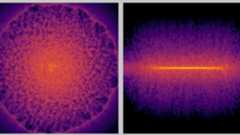Dusty Structure of Milky Way Galaxy Revealed in New 3D Map
When you purchase through links on our site, we may earn an affiliate commission.Here’s how it works.

A new 3D map of the Milky Way galaxy shows the dust that permeates the galaxy in great detail.
Astronomers mapped the dust between stars in theMilky Way to create the colorful image, which covers the part of the galaxy seen from Earth's Northern Hemisphere. The dustiest regions of the galaxy are colored red, while lighter colors are less dusty.
Instead of measuring thegalaxy's dust directly, the international group of researchers observed more than 38 million stars to see how much light from those stars is masked by dust. The map was produced by data gathered by the Isaac Newton Telescope Photometric H-alpha Survey of the Northern Galactic Plane (IPHAS).



"We can see a number of specific features, including the Rosette Nebula and the star-forming belt in the Perseus Arm of the Milky Way," Stuart Sale, who led the team that created the map,said in a statement. "Our location within the Milky Way means that we can study the ISM [interstellar medium] in far greater detail than for any other galaxy. The knowledge that we gain from studying our own galaxy can subsequently be applied to others."
"Because thesolar system is embedded in the disc of the Milky Way, our view of it is choked with dust, with the result we know less about its internal structure than we do about some external galaxies, such as M31 in Andromeda." Janet Drew, the principal investigator for the IPHAS, said in a statement.
"In this northern survey, we are mainly looking at the parts of the galactic disc that lie outside the sun's orbit around the galactic center," Drew added. "This 3D map demonstrates with greater force than existing 2D maps that dust in the outer disc does not trace the Perseus spiral arm and other expected structures in a simple way."
Breaking space news, the latest updates on rocket launches, skywatching events and more!
Follow Miriam Kramer@mirikramerandGoogle+. Follow us@Spacedotcom,Facebook andGoogle+. Original article on Space.com.

Miriam Kramer joined Space.com as a Staff Writer in December 2012. Since then, she has floated in weightlessness on a zero-gravity flight, felt the pull of 4-Gs in a trainer aircraft and watched rockets soar into space from Florida and Virginia. She also served as Space.com's lead space entertainment reporter, and enjoys all aspects of space news, astronomy and commercial spaceflight. Miriam has also presented space stories during live interviews with Fox News and other TV and radio outlets. She originally hails from Knoxville, Tennessee where she and her family would take trips to dark spots on the outskirts of town to watch meteor showers every year. She loves to travel and one day hopes to see the northern lights in person. Miriam is currently a space reporter with Axios, writing the Axios Space newsletter. You can follow Miriam on Twitter.























